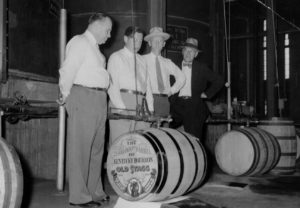Once upon a time, David Avedissian wasn’t much of a booze aficionado. He never sipped spirits at home and rarely ever drank whiskey.
“I would maybe order vodka at a bar,” he said.
That all changed on a vacation to Kentucky in 2004, when he and his partner toured one of the state’s legendary bourbon distilleries.
“I drank bourbon for the first time on that trip,” he says. “I was like, ‘Woah.’ A light went off.”
Avedissian started enjoying the popular, easy-to-find bourbons on the market, such as Maker’s Mark and Woodford Reserve.
Then one day, a friend told him to buy a special bottle of George T. Stagg, a limited-release bourbon named for a 19th-century whiskey pioneer. Even though it seemed pricey (around $50 at the time) he loved the taste. He ended up buying more bottles of George T. Stagg than he could open and drink.

Fast forward to 2021, and those unopened bottles now sell for over $2,000 apiece.
“My friend told me, ‘There’s a whole world outside of everyday bourbon,’” Avedissian says. “He was right.”
A decade and a half since that light-bulb moment in Kentucky, Avedissian is now a serious collector of bourbon. The value of the bourbons in his suburban New Jersey cellar is conservatively estimated at around $500,000—though likely more at auction.
Besides his 15 bottles of George T. Stagg, there are cases of Elmer T. Lee worth $500 each, William Larue Wellers that now sell for $2,000 each, Jefferson Presidential 17-year-olds worth more than $5,000 apiece (“that is the best whiskey you will ever taste” says Avedissian, “it is sublime”) and a 16-year-old A.H. Hirsch (made in 1974) with a gold wax seal that’s been valued at around $15,000.

And then there are his 70 or so bottles of mythical Pappy Van Winkle, the unicorn of bourbons. Avedissian has a mix of 10-, 12-, 15-, and 20-year-old Pappy Van Winkle. The old rule of thumb in Pappy pricing had been roughly $100 per year of age. In 2018, a 23-year-old Pappy Van Winkle was auctioned at $20,000. But even that is an old calculation. The ceiling right now seems limitless for coveted bottles.

Collectors like Avedissian, who started buying their bourbons in the aughts and early 2010s, have seen astronomical growth in value.
“I’ve never spent more than $200 on a bottle of whiskey,” he says. “Ever.”
That growth has happened because the sort of dude who once spent his coin on Bordeaux and Burgundy wines now desperately wants to become a Whiskey Bro. In many ways, spirits are a better investment than wine. Whiskey (or brandy or rum) has a much longer shelf life than wine—once a wine is open it must be consumed within a few days.
But bourbon prices have recently entered the stratosphere. So much so that a shadowy secondary market of flippers has emerged, with people selling coveted bottles for thousands of dollars.
“Bourbon is not just something you can consume. It’s a lifestyle. It’s a form of entertainment,” says Fred Minnick, author and bourbon expert.

Source: Buffalo Trace Distillery
Minnick has curated the collections of numerous wealthy bourbon aficionados, and he consults for auction houses and charity auctions.
“People pay me to sit in a room and drink with them, and to educate them.”
Minnick identifies three types of collectors. The first is the true fan, the one who actually loves the taste of bourbon.
“They’re spending the money because they’re going to drink it. It’s meant to be enjoyed, and it’s very important that they share that bottle.”
Minnick is often the beneficiary of this sharing. With a laugh, he recounts the story of a recent Pappy Van Winkle sale ($15,000) that he was involved in.
“The buyer said, ‘I’d love for you to come out to California to drink this’ and I said, ‘Well, let me check my schedule.’”
Then, the second type of collector is the status seeker.
“The one who says, ‘I have so much fucking money I’m going to buy this and show it off like it’s my new Ferrari,’” Minnick says. “The bottle sits on the shelf like a big middle finger to all his other rich friends. These are the people who way over-spend at charity auctions.”
Finally, there is the bourbon investor.
“Maybe they care about whiskey, maybe they don’t,” Minnick says.
These investors are looking to cash in on the exploding market. Investing in Pappy has yielded sizeable returns. Fifteen years ago, you could find a bottle of Pappy Van Winkle for $200. Now, you can sell the same bottle at auction for at least $5,000.
Still, Minnick says, “when the bubble bursts, these collectors will be gone.”
Not that Minnick sees the bourbon bubble bursting any time soon.
“If we look at it like a baseball game, we’re probably on second base. There are signs that the bubble could burst, but I’m more optimistic.”
Part of what’s created the excitement over spirits has been celebrities wading into the business, perhaps trying to duplicate the success of George Clooney’s Casamigos Tequila, which he and his partners sold to Diageo for $1 billion in 2017. Many of these celebrity-backed spirits have been lame or irrelevant or simply novelty (Danny Devito’s limoncello anyone?) but many have added a sheen of glamour to the market. Some are pretty good, such as Nick Offerman’s 11-year-old Scotch or Matthew McConaughey’s special Wild Turkey bottling. Even the gore metal band GWAR did a well-regarded whiskey selection with Catoctin Creek. And some celebs, such as Jay-Z, are legit curators of spirits. Jay-Z’s own Cognac label D’Usse gets solid reviews, and Sotheby’s just auctioned a 1969 vintage this year for $52,000.

Source: Sotheby’s
In the world of bourbon, there was what Avedissian calls “the Bourdain effect.” Around the time when Anthony Bourdain touted Pappy Van Winkle in a 2012 episode of his show (“If God made bourbon, this is what he’d make,” Bourdain said) the bourbon went from being coveted among insiders to a full-blown cultural totem.
“Let’s just say I have not been able to buy much 20- or 23- year-old Pappy since about 2013,” Avedissian says.
Still, celebrity aside, the bourbon collector market is largely driven by a connected network of whiskey geeks—the Sneakerheads of the booze universe. In fact, collecting special whiskies is similar to collecting special edition sneakers. With bourbon, there’s always a new single-barrel offering, a special distillers selection, a rare vintage, or a limited edition label.
And just like in other collectibles markets, there is the manufacture of “collectibility.” Unlike in wine, where ratings on the 100-point scale by wine critics drive demand for top wines from Bordeaux or Barolo, the bourbon market is not moved by ratings and reviews in the same way. Avedissian says there have been numerous cases where limited-edition whiskeys have received terrible ratings from critics, but it didn’t matter.
“Scarcity matters,” he says, adding: “The demand and scarcity sometimes feels artificial.”
This scarcity is often created at the local level. Shops and bars around the country often make one-of-a-kind barrel selections. But now, private whiskey clubs, with a few dozen members, will combine buying power to select special barrels direct from distillers. Those barrels become a special limited run of a couple hundred bottles for club members, with some of the excess allocation going to a local retailer.
The appeal of barrel picks to collectors is easy to understand. Selecting your own special whiskey feels more dynamic than collecting wine because you get to be part of the curation process.
A few of these barrel selections have become coveted, but at this point many collectors feel it’s overdone.
“Barrel programs really became a thing around 2010,” says Avedissian. “Now, there’s too many people doing it. Most stores are not getting the great barrel picks anymore. No offense, and I don’t want to sound like a snob, but I don’t need a club to tell me where to run around and buy whiskey.”
Instead, Avedissian suggests forging a close relationship with retail outlets who regularly get allocations of prized bourbons.
The real scarcity in bourbon derives from acquiring whiskeys from distilleries that no longer exist. For instance, specific bourbons made at Kentucky’s Stitzel-Weller distillery, which closed in 1992, are highly sought after. Stitzel-Weller is the distillery founded by the actual, nonfictional Julian “Pappy” Van Winkle.

Source: Wikipedia
That type of scarcity can’t last forever. Some collectors are thinking about what’s next. Minnick suggests that Armagnac, the brandy made in the French region of Gascony, might be the next big thing.
“In 10 years, Armagnac will be the buy of a lot of people who are bourbon drinkers,” Minnick says. “If I’m a collector, an investor, I’m chasing that. Someone who comes in and buys Armagnac would be like buying Pappy in 2004.”
That may be true, since Armagnac’s taste profile may appeal to the bourbon drinker.
“There’s more Armagnac being sold, but it’s a very specific kind of Armagnac sold to a specific kind of buyer,” says Nicolas Palazzi of PM Spirits, who is a top importer of Armagnac. “We’re talking about Armagnac that’s very extracted, heavier on the wood, more powerful, more vanilla. So, it’s not very different than the whiskey that people are drinking.”
Right now, you can buy plenty of Armagnacs with 50 years of aging for less than $500 a bottle.

Michael Buffa, of the 200-member Orlando Whiskey Society, is one of these converts from whiskey to brandy. Buffa started a side group in central Florida with about a dozen people, called the Yak Pack, when his taste for Armagnac began to usurp his taste for whiskey.
“Armagnac has way more to offer than bourbon, personally,” he says. “In the secondary markets, what bourbon is selling for is absolutely ridiculous. Bourbon drinkers are very susceptible to trends.”
The Yak Pack has already selected several brandy barrels.
“The idea is to start creating buying power in brandy,” he says.
While the Yak Pack quickly gains experience and more exposure to brandy, Buffa notes this knowledge is rare. Whiskey brands have so many more reps out in the field doing so-called “education marketing.”
“Armagnac drinking for Americans is in its infancy,” Buffa says. “There really aren’t a lot of brandy experts.”
All this speculation in spirits might sound a bit familiar. The New York Times mentions collecting whiskey alongside investing in more established collectible categories like watches, sneakers, and Pokémon. The key difference, for now, is that institutional money hasn’t piled into the spirits world in the same way that it has in the world of sports cards, toys, or NFTs. Spirits collecting is still primarily the domain of the knowledgeable amateur. At least for now.
Avedissian says he’s been thinking about cashing out of his whiskey collection and investing in Armagnac. However, he remembers the episode of The Sopranos when Tony’s restaurateur pal Artie Bucco gets suckered into a bad business deal to import Armagnac. It’s a reminder that collecting or investing in any kind of alternative assets can be a risk.
“Armagnac didn’t really end well for Artie Bucco,” Avedissian says.
Expand your investment portfolio beyond cards
For many, collecting and trading cards is more than just a hobby. And when youre ready to explore opportunities beyond the world of cards, Public is here to help. On Public, you can build a multi-asset portfolio of stocks, options, bonds, crypto, ETFs and more. Plus, you can access AI-powered fundamental data and custom analysis to guide your investment decisions.
Sign up today and explore how you can expand your investment portfolio beyond card collecting. With options like high-yield cash accounts (HYCA) and expert guidance on stocks, crypto, and ETFs, Public is your platform for smarter investing.

